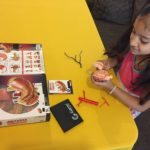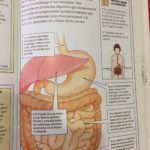Biología
EL PAPEL DE LOS CINCO SENTIDOS EN EL PROCESO DE DIGESTIÓN – ALIMENTACIÓN
- Categoría: Pandilla Petit, (preescolar y 1ro. y 2do. año de primaria)
- Área de participación: Biología
- Asesor: ROSALIA ORNELAS ENRÍQUEZ
- Autor: Helena Aviles Landeros ()
Resumen
El papel de los cinco sentidos en el proceso de digestión y la alimentación no se limita exclusivamente al sabor o al olor de los alimentos; ¿Cuantas veces hemos escuchado que la comida entra por los ojos?… Está claro que el sabor es fundamental, pero también el resto de los sentidos de un modo u otro participan.

El proceso de las sensaciones que percibimos al probar un platillo es muy complejo, e intervienen capacidades innatas y adquiridas, que se van desarrollando e interactúan durante toda la vida. Estas sensaciones, dependen por un lado de nuestras capacidades y por el otro, del alimento por sí mismo.

Pregunta de Investigación
¿El proceso de digestión/alimentación podría afectarse si alguno de nuestros cinco sentidos no se encuentra bien desarrollado?Planteamiento del Problema
En la actualidad cada vez se incrementan más las enfermedades originadas por un mal proceso de digestión/alimentación en las personas, motivo por el cual es importante que se dé a conocer cómo podemos mejorar este proceso al desarrollar mejor nuestros cinco sentidos desde que nos estamos desarrollando en el vientre materno y como es una prioridad que estos sentidos se sigan estimulando en todas las etapas de la vida tanto en casa como en la escuela o trabajo.
Antecedentes
Los sentidos, con relación a la alimentación, han formado parte de la evolución y de la supervivencia del ser humano.
Al igual que ocurre con numerosas especies animales, el ser humano sólo come aquello que reconoce tras un largo período de aprendizaje previo. Los hombres primitivos se educaban en alimentación observando lo que tomaban los demás miembros de la tribu y, sobre todo, lo que les ofrecían sus progenitoras. En esta necesaria actividad de supervivencia agudizaban los cinco sentidos.
Este tipo de precauciones ancestrales constituían un mecanismo de seguridad esencial para evitar accidentes, envenenamientos u otro tipo de perjuicios para la integridad física del hombre. La antropología considera que esta actitud responde, en parte, a un comportamiento heredado del instinto de nuestros genes animales que nos hacía resistentes a probar alimentos desconocidos.
La información que nos llega de los alimentos es básicamente sensorial, por lo que ponemos en ello los cinco sentidos.
El cerebro y el sistema digestivo trabajan juntos. Los científicos saben hace tiempo que el cerebro estimula los órganos del sistema digestivo a través de la visión, el olfato y el gusto, los cuales a su vez estimulan el hambre. También factores psicológicos tienen su influencia sobre el hambre y la digestión, como por ejemplo una tristeza profunda puede influir en los intestinos provocando problemas digestivos y anulando también en gran medida la sensación de hambre. Además se está estudiado, como enfermedades crónicas del sistema digestivo como el Síndrome del Colon Irritable o la Colitis Ulcerosa afectan nuestras emociones, comportamientos y vitalidad. Esta asociación es llamada hoy por investigadores y científicos la Relación o Eje Cerebro-Intestino.

Es muy importante entonces que en ciertas personas se haga una intervención en su dieta a nivel intestinal, ya que curando el tracto intestinal y liberando el sobre crecimiento de bacterias y hongos, se influirá en las emociones y el comportamiento. Estos compuestos de bacterias y hongos producidos en la zona intestinal pueden entrar en la circulación sanguínea como toxinas y cruzar, a través de la sangre, la barrera del cerebro. También ya se han publicado reportes que explican cómo estas toxinas del tracto intestinal afectan negativamente los neurotransmisores en el cerebro.
El cerebro intestinal produce sustancias psicoactivas que influyen en el estado de ánimo, como los neurotransmisores serotonina y dopamina, así como diferentes opiáceos que modulan el dolor. Además, sintetiza benzodiacepinas, compuestos químicos que tienen el mismo efecto tranquilizante que el Valium. Neurotransmisores como la serotonina, la dopamina, el glutamato, la noradrenalina y el óxido nítrico que siempre se pensó que solo estaban en el cerebro, bañan las células nerviosas del intestino igual que lo hacen en el cerebro. A medida que se conocen más detalles sobre la relación entre los dos cerebros, se entienden mejor algunos síntomas psíquicos frecuentes. El intestino manda más información al cerebro de la que recibe de éste.

LA VISTA
Es el primer sentido que entra en juego cuando el platillo llega a la mesa, y el primero con el que percibimos la comida; a través de ella tenemos acceso a una serie de elementos que constituyen la composición del plato:
- Cantidad que se sirve
- Identificación del producto y sus elaboraciones (forma de preparación).
- de los elementos en el plato (presentación).
- Formas de los elementos
- Colores y matices de los productos
Con la vista “comemos”, hace que nos apetezcan, o no, los alimentos, funcionando en este sentido como reguladora del apetito; pero es un sentido que por sí solo nos engaña, ya que, en varias ocasiones no nos permite medir las cantidades y pedimos en exceso.

EL OLFATO
Después de apreciar visualmente el platillo, procedemos a sentir sus aromas; el ser humano es capaz de distinguir unos 20.000 olores diferentes, cada uno de ellos con 10 o más grados distintos de intensidad. La concentración de todos los aromas del plato, es lo que el comensal huele cuando tiene el plato delante, es decir, la armonía del plato. El sentido del olfato es importante a la hora de comer porque ayuda a preparar los jugos gástricos que después participan en la digestión de los alimentos y también porque el olor de un alimento puede indicar que este no está en buen estado.

EL GUSTO
Se localiza en la boca y principio de la faringe, y se estimulan a partir de partículas que caracterizan los sabores disueltas en la saliva. Se piensa en general que existen cuatro sensaciones primarias:
- Ácido
- Dulce
- Salado
- Amargo
Pero en realidad, una persona puede percibir cientos o miles de gustos diferentes, todos ellos son combinaciones de las cuatro primarias. El verdadero gusto de los alimentos se detecta en los sensores específicos que se encuentran en la lengua “las papilas gustativas”, el ser humano posee cerca de 10.000 de estas papilas.
Elementos que afectan al gusto:
- Reacciones de defensa del organismo, por ejemplo salivación excesiva en la boca para diluir el zumo de limón.
- La temperatura a la que se consumen los alimentos.
- Tabaco
- Mezclar gustos primarios
- La edad
- Mujeres embarazadas
El sabor es la impresión que nos causa un alimento, y está determinado por sensaciones químicas detectadas por el gusto (paladar), así como por el olfato (olor). Lo que comúnmente denominamos “gusto”, es en realidad el sabor, el cual es la interacción entre los sentidos del gusto y el olfato; el olor es el principal determinante del sabor de un alimento, el 80% de lo que se detecta como sabor es procedente de la sensación de olor. Una disminución de la función de un sentido, afecta la función del otro.

EL TACTO
Juega dos papeles importantes a la hora de consumir un alimento, uno es con respecto a la textura y el otro a la temperatura de los mismos. Al introducirnos un alimento en la boca, lo primero que percibimos es la temperatura, factor muy importante a la hora de valorar un platillo, y desgraciadamente no siempre se le da la importancia que debería; servir a diferentes temperaturas un mismo alimento, puede hacernos variar nuestra percepción respecto a él, puede hacer que algo nos guste más o menos.
Después de la temperatura, percibimos la sensación táctil “la textura”; en muchas ocasiones no se quiere probar un plato no tanto porque a uno no le guste el sabor, sino porque no nos apetece su textura. La combinación de diferentes texturas es un placer tan grande como la mejor asociación de gustos.
El tacto ha sido en estos últimos años, uno de los sentidos más explotados gracias a las diferentes texturas que se han ido creando: nubes, espumas, algodones, gelatinas…
Además la textura de muchos alimentos se percibe también por el contacto con la piel de las manos, como cuando tomamos una manzana o una pera, etc.

El OIDO
El oído participa, aunque en menor medida que el resto de los sentidos, aportando información al cerebro cuando comemos alimentos o productos de textura crujiente.
“el sonido que se transmite por vía ósea de los dientes al oído tiene que ver en nuestro reconocimiento de algunos alimentos, como son los más crujientes, en los que cuesta identificar hasta dónde llega la información táctil de la lengua y hasta dónde la sonora por el ruido que hacemos al masticar”.

PROCESO DE DIGESTIÓN:
- El proceso digestivo comienza en la boca, donde los alimentos son triturados por la acción de los dientes y sometidos a la acción de la saliva.
- El bolo alimenticio atraviesa el esófago mediante la deglución para llegar al estómago.
- En el estómago los alimentos se almacenan temporalmente y son sometidos a la acción del corrosivo jugo gástrico producido por las glándulas de la mucosa que tapiza el órgano.
- El hígado segrega la bilis imprescindible para la digestión de las grasas, sirve de depósito de vitaminas, de proteínas y de glucógeno, interviene en el metabolismo de los lípidos, sintetiza proteínas y convierte sustancias tóxicas en inocuas.
- La vesícula biliar almacena la bilis y, posteriormente, la vierte en el duodeno.
- El jugo pancreático interviene en la digestión de todos los alimentos orgánicos.
- En el duodeno se vierten los jugos pancreático, biliar e intestinal que digieren los alimentos y se absorben los nutrientes.
- Durante todo el trayecto del intestino delgado tiene lugar la digestión y absorción de los nutrientes.
- En el colon finaliza el largo recorrido del bolo alimenticio y se forma la materia fecal.
- Por el recto y el ano se expulsan los detritus o residuos de todo el proceso digestivo.


Objetivo
Dar a conocer como los cinco sentidos (vista, olfato, gusto, tacto y oído) intervienen en el proceso de digestión/alimentación y a su vez como este proceso puede mejorar o afectar nuestro comportamiento y calidad de vida.
Justificación
He notado que cuando tengo gripa la comida no me sabe igual y que cuando me dan un platillo y no me gusta como se ve me produce dolor de estómago. Motivo por el cual empecé a buscar respuestas a la siguiente pregunta.
Hipótesis
Si una persona no tiene bien desarrollados sus 5 sentidos (vista, olfato, gusto, tacto y oído) o tiene una enfermedad que afecta alguno de ellos; entonces el proceso de digestión – alimentación se verá limitado y a su vez se reflejara en el comportamiento y calidad de vida de la misma.
Método (materiales y procedimiento)
Investigar en diferentes fuentes de información acerca de este tema.
Acudí a La Biblioteca Vasconcelos de la Ciudad de México, donde pude buscar en el área infantil y encontrar varios libros que hablaban del cuerpo humano, su estructura y su función.
Además busque información en diferentes páginas de internet y pude encontrar varios videos que dan a conocer el proceso de digestión y como intervienen los cinco sentidos en el mismo.
Use materiales didácticos para entender como es el sistema digestivo.
Resultados
Pude entender como intervienen los cinco sentidos en el proceso de digestión/alimentación, que cuando uno de ellos no funciona como debería este proceso se ve afectado y comprendí él porque es tan importante que desarrollemos nuestros cinco sentidos al máximo, para así poder disminuir la probabilidad de padecer enfermedades relacionadas con un mal proceso de digestión/alimentación y poder gozar de una mejor calidad de vida.
Discusión
Conclusiones
Cada uno de nuestros sentidos es importante y cumple su papel a la hora de valorar un alimento o platillo preparado, además estos intervienen en el proceso de digestión, si alguno de ellos no se encuentra bien desarrollado este proceso puede ser alterado y en algunas personas causar enfermedades que pueden afectar el comportamiento de los seres humanos y su calidad de vida.
Comer con todos los sentidos puede hacernos disfrutar mucho más de la comida y gozar de una buena salud.

Bibliografía
- “La alimentación a través de los sentidos”; Alimmenta dietistas-nutricionistas; Clínica Alimmenta, Barcelona; https://www.dietistasnutricionistas.es/la-alimentacion-traves-de-los-sentidos/
- “El papel de los sentidos en la alimentación”; Alimentatubienestar; Salud y Bienestar; https://www.alimentatubienestar.es/papel-de-los-sentidos-en-la-alimentacion/
- “Comer con los cinco sentidos: sabor, olor, textura… ¡sí importa! http://www.mujerhoy.com/reportajes/comer,cinco,sentidos,sabor,81978,04,2009.html
- ¿Cuál es la conexión entre la digestión, los intestinos y el cerebro?; Vidaraw; febrero 2012; https://vidaraw.wordpress.com/2012/02/27/cual-es-la-conexion-entre-la-digestion-los-intestinos-y-el-cerebro/
- Video YouTube: “Los cinco sentidos; videos educativos para niños”; https://www.youtube.com/watch?v=K5Pkh-iqAcg.
- Video YouTube: “El sistema digestivo; Nueva versión”; https://www.youtube.com/watch?annotation_id=annotation_1343657477&feature=iv&src_vid=XpH9Z4hTQsE&v=1Y7TCKsPTe4
- Video YouTube: “¿Cómo funciona el cuerpo humano; videos educativos para niños; https://www.youtube.com/watch?v=zabVr2bGrik
- “El sistema Digestivo ¿Qué es la digestión?; https://www.youtube.com/watch?v=5DUIc9BchOk
- “Proceso Digestivo”; Doctissimo 2017; http://www.doctissimo.com/mx/salud/atlas-del-cuerpo-humano/aparato-digestivo/proceso-digestivo
- “El cazador de cerebros – Nutrición personalizada”; España, Octubre 2016; http://www.rtve.es/alacarta/videos/el-cazador-de-cerebros/cazador-cerebros-nutricion-personalizada/3749908/
EL PAPEL DE LOS CINCO SENTIDOS EN EL PROCESO DE DIGESTIÓN – ALIMENTACIÓN
Summary
The role of the five senses in the process of digestion and feeding is not limited exclusively to the taste or smell of food; How many times have we heard that food enters our eyes? … It is clear that taste is fundamental, but also the rest of the senses participate in one way or another.

The process of the sensations that we perceive when tasting a dish is very complex, and innate and acquired capacities intervene, which are developed and interact throughout life. These sensations depend, on the one hand, on our capacities and on the other, on the food itself.

Research Question
Could the digestion / feeding process be affected if one of our five senses is not well developed?Problem approach
Nowadays the diseases caused by a bad process of digestion / feeding in people are increasing every time, which is why it is important that we know how we can improve this process by developing our five senses better since we are developing in the womb and how it is a priority that these senses continue to be stimulated in all stages of life both at home and at school or work
Background
The senses, in relation to food, have been part of the evolution and survival of the human being.
As with many animal species, humans only eat what they recognize after a long period of prior learning. Primitive men were educated in food, observing what other members of the tribe took and, above all, what their progenitors offered them. In this necessary activity of survival they sharpened the five senses.
This type of ancestral precautions constituted an essential safety mechanism to avoid accidents, poisonings or other types of damage to the physical integrity of man. Anthropology considers that this attitude responds, in part, to a behavior inherited from the instinct of our animal genes that made us resistant to try unknown foods.
The information that comes to us from food is basically sensory, so we put in it the five senses.
The brain and the digestive system work together. Scientists have long known that the brain stimulates the organs of the digestive system through vision, smell and taste, which in turn stimulate hunger. Also psychological factors have their influence on hunger and digestion, as for example a deep sadness can influence the intestines causing digestive problems and also greatly nullifying the feeling of hunger. It is also being studied, as chronic diseases of the digestive system such as Irritable Colon Syndrome or Ulcerative Colitis affect our emotions, behaviors and vitality. This association is today called by researchers and scientists the Relationship or Brain-Intestine Axis.

It is very important then that in certain people an intervention is made in their diet at the intestinal level, since by curing the intestinal tract and releasing the overgrowth of bacteria and fungi, emotions and behavior will be influenced. These compounds of bacteria and fungi produced in the intestinal area can enter the bloodstream as toxins and cross, through the blood, the brain barrier. Reports have already been published that explain how these toxins from the intestinal tract negatively affect neurotransmitters in the brain.
The intestinal brain produces psychoactive substances that influence mood, such as the neurotransmitters serotonin and dopamine, as well as different opioids that modulate pain. In addition, it synthesizes benzodiazepines, chemical compounds that have the same tranquilizing effect as Valium. Neurotransmitters such as serotonin, dopamine, glutamate, noradrenaline and nitric oxide that were always thought to be only in the brain, bathe the nerve cells of the intestine just as they do in the brain. As more details are known about the relationship between the two brains, some common psychic symptoms are better understood. The intestine sends more information to the brain than it receives from it.

THE VIEW
It is the first sense that comes into play when the dish arrives at the table, and the first with which we perceive the food; Through it we have access to a series of elements that make up the composition of the dish:
• Amount served
• Identification of the product and its elaborations (form of preparation).
• Organization of the elements on the plate (presentation).
• Forms of the elements
• Colors and nuances of the products
With the sight “we eat”, it makes us want, or not, food, functioning in this sense as a regulator of appetite; but it is a sense that by itself deceives us, since, in several occasions it does not allow us to measure the quantities and we ask in excess.

THE SENSE OF SMELL
After visually appreciating the dish, we proceed to feel its aromas; the human being is able to distinguish some 20,000 different smells, each of them with 10 or more different degrees of intensity. The concentration of all the aromas of the dish, is what the diner smells when the dish is in front, that is, the harmony of the dish. The sense of smell is important at the time of eating because it helps to prepare the gastric juices that later participate in the digestion of food and also because the smell of a food may indicate that it is not in good condition.

TASTE
It is located in the mouth and beginning of the pharynx, and is stimulated by particles that characterize the dissolved flavors in the saliva. It is generally thought that there are four primary sensations:
• Acid
• Candy
• Salty
• Bitter
But in reality, a person can perceive hundreds or thousands of different tastes, they are all combinations of the four primaries. The true taste of food is detected in the specific sensors found in the tongue “taste buds”, the human being has about 10,000 of these papillae.
Elements that affect taste:
• Defense reactions of the organism, for example excessive salivation in the mouth to dilute the lemon juice.
• The temperature at which food is consumed.
• Tobacco
• Mix primary tastes
• Age
• Pregnant women
Taste is the impression that a food causes us, and is determined by chemical sensations detected by taste (palate), as well as by smell (smell). What we commonly call “taste” is actually taste, which is the interaction between the senses of taste and smell; the smell is the main determinant of the flavor of a food, 80% of what is detected as flavor is coming from the smell sensation. A decrease in the function of one direction affects the function of the other.

THE TOUCH
Play two important roles when consuming a food, one is with respect to the texture and the other at the temperature of the same. When introducing a food to us in the mouth, the first thing we perceive is the temperature, a very important factor when evaluating a dish, and unfortunately it is not always given the importance it should; to serve the same food at different temperatures, it can make us vary our perception about it, it can make us like something more or less.
After the temperature, we perceive the tactile sensation “the texture”; In many occasions you do not want to try a dish not so much because you do not like the taste, but because we do not want its texture. The combination of different textures is a pleasure as great as the best association of tastes.
Touch has been in recent years, one of the most exploited senses thanks to the different textures that have been created: clouds, foams, cotton, gelatin …
In addition, the texture of many foods is also perceived by the contact with the skin of the hands, as when we take an apple or a pear, etc.

THE EAR
The ear participates, although to a lesser extent than the rest of the senses, providing information to the brain when we eat foods or products of crunchy texture.
“The sound that is transmitted through the bones of the teeth to the ear has to do with our recognition of some foods, such as the most crunchy ones, in which it is difficult to identify how far the tactile information of the tongue reaches and how far the the noise we make when chewing. ”

DIGESTION PROCESS:
1. The digestive process begins in the mouth, where the food is crushed by the action of the teeth and subjected to the action of saliva.
2. The food bolus goes through the esophagus by swallowing to reach the stomach.
3. In the stomach food is stored temporarily and is subjected to the action of corrosive gastric juice produced by the glands of the mucosa that upholsters the organ.
4. The liver secretes the essential bile for the digestion of fats, serves as a storehouse of vitamins, proteins and glycogen, intervenes in the metabolism of lipids, synthesizes proteins and converts toxic substances into harmless ones.
5. The gall bladder stores the bile and then pours it into the duodenum.
6. Pancreatic juice intervenes in the digestion of all organic foods.
7. In the duodenum pancreatic, biliary and intestinal juices are discharged that digest food and absorb nutrients.
8. Digestion and absorption of nutrients take place throughout the course of the small intestine.
9. In the colon, the long course of the food bolus ends and the stool is formed.
10. The detritus or waste of the entire digestive process is expelled through the rectum and anus.


Objective
Make known how the five senses (sight, smell, taste, touch and hearing) intervene in the digestion / feeding process and in turn how this process can improve or affect our behavior and quality of life.
Justification
I have noticed that when I have a cold the food does not taste the same to me and that when they give me a dish and I do not like what it looks like, it causes stomach pain. Reason why I started looking for answers to the next question.
Hypothesis
If a person does not have well developed their 5 senses (sight, smell, taste, touch and hearing) or has a disease that affects any of them; then the process of digestion – feeding will be limited and in turn will be reflected in the behavior and quality of life of it.
Method (materials and procedure)
Investigate different sources of information about this topic.
I went to the Vasconcelos Library in Mexico City, where I was able to search the children’s area and find several books that talked about the human body, its structure and its function.
Also look for information on different websites and I could find several videos that show the digestion process and how the five senses intervene in it.
Use didactic materials to understand how the digestive system is.
Results
I could understand how the five senses intervene in the digestion / feeding process, that when one of them does not work as it should this process is affected and I understood it because it is so important that we develop our five senses to the maximum, in order to decrease the probability of suffering diseases related to a bad digestion / feeding process and to be able to enjoy a better quality of life
Discussion
Conclusions
Each of our senses is important and fulfills its role when it comes to assessing a prepared food or dish, in addition they intervene in the digestion process, if one of them is not well developed this process can be altered and in some people cause diseases that can affect the behavior of human beings and their quality of life.
Eating with all the senses can make us enjoy the food much more and enjoy good health.

Bibliography
- “La alimentación a través de los sentidos”; Alimmenta dietistas-nutricionistas; Clínica Alimmenta, Barcelona; https://www.dietistasnutricionistas.es/la-alimentacion-traves-de-los-sentidos/
- “El papel de los sentidos en la alimentación”; Alimentatubienestar; Salud y Bienestar; https://www.alimentatubienestar.es/papel-de-los-sentidos-en-la-alimentacion/
- “Comer con los cinco sentidos: sabor, olor, textura… ¡sí importa! http://www.mujerhoy.com/reportajes/comer,cinco,sentidos,sabor,81978,04,2009.html
- ¿Cuál es la conexión entre la digestión, los intestinos y el cerebro?; Vidaraw; febrero 2012; https://vidaraw.wordpress.com/2012/02/27/cual-es-la-conexion-entre-la-digestion-los-intestinos-y-el-cerebro/
- Video YouTube: “El sistema digestivo; Nueva versión”; https://www.youtube.com/watch?annotation_id=annotation_1343657477&feature=iv&src_vid=XpH9Z4hTQsE&v=1Y7TCKsPTe4
- Video YouTube: “Los cinco sentidos; videos educativos para niños”; https://www.youtube.com/watch?v=K5Pkh-iqAcg.
- Video YouTube: “¿Cómo funciona el cuerpo humano; videos educativos para niños; https://www.youtube.com/watch?v=zabVr2bGrik
- “El sistema Digestivo ¿Qué es la digestión?; https://www.youtube.com/watch?v=5DUIc9BchOk
- “Proceso Digestivo”; Doctissimo 2017; http://www.doctissimo.com/mx/salud/atlas-del-cuerpo-humano/aparato-digestivo/proceso-digestivo
- “El cazador de cerebros – Nutrición personalizada”; España, Octubre 2016; http://www.rtve.es/alacarta/videos/el-cazador-de-cerebros/cazador-cerebros-nutricion-personalizada/3749908/










